This article was co-authored by Indy Chabra, MD, PhD. Dr. Indy Chabra is a Board Certified Dermatologist and a Board Certified Mohs Micrographic Surgeon. He is the Founding Member of DMC Dermatology & Mohs based in Tucson, Arizona. With over 15 years of experience, he provides medical, surgical, and cosmetic dermatology care for adult and pediatric patients. Dr. Chabra earned a BS in Chemistry and Biological Sciences and an AB in Economics from Stanford University. He also received his MD and PhD in Microbiology and Genetics from Stony Brook University. He completed his Dermatology residency at the University of Pittsburgh Medical Center (UPMC), Pittsburgh. While at UPMC, Dr. Chabra received extensive training in complex Medical Dermatology, hair and nail conditions, Pediatric Dermatology, Cosmetic Dermatology, and Mohs Skin Cancer Surgery. Dr. Chabra is a Fellow of the American Society for Mohs Surgery, a Fellow of the American Academy of Dermatology, and a Fellow of the American Society for Dermatologic Surgery. Dr. Chabra also provides in-patient Dermatology consults at Tucson Medical Center.
There are 16 references cited in this article, which can be found at the bottom of the page.
This article has been viewed 170,917 times.
A curling iron is a great tool for making your hair look good. But, because it is so close to your face, it can burn you on this very sensitive and exposed part of your body. If you react quickly, and treat the burn properly, you’ll reduce the chances of getting a nasty scar as a souvenir.
Steps
Cleaning the Burn
-
1Turn off the curling iron. You’ll need to focus on cleaning off the burn right now, and you don’t want to worry about the curling iron. Turn it off or unplug it, and set it down somewhere out of the way so you don’t accidentally touch it while taking care of yourself.
-
2Identify the kind of burn you have. There are three kinds of burns you can get on your skin. Each type requires a different kind of treatment, so you’ll need to be sure what you have before doing anything else.[1]
- First-degree burns are the most common and least serious. These are minor burns that you can treat yourself. A first-degree burn will have redness, swelling, and pain.[2] If the burn involves most of your face, though, treat it more seriously and get emergency medical help.
- Second-degree burns are more serious, and your treatment will depend on the size of the burn. A second-degree burn may have red, white, or splotchy skin, swelling, pain, and blisters. If the burn is 3 inches or smaller, you can treat it like a minor burn. If it is larger, treat like a major burn and get medical help immediately.
- Third-degree burns are the most serious, and involve burning off all the skin and underlying fat. The area may be charred black or white. If you have a third-degree burn, you may also experience difficulty breathing, carbon monoxide poisoning, or other toxic effects from smoke inhalation. You probably won’t get a third-degree burn from a curling iron, but it is something you should be aware of.
Advertisement -
3Cool the burn. Running water is not recommended for any burn, as it can damage the swollen, injured skin and increase blistering/scarring. However, you can hold a cool, clean wet cloth on the burn for 5 minutes to help cool it down.[3]
- The water should be cool, not cold, so avoid ice or cold water.
- Water is the best choice for cleaning. Irritants like harsh soap, hydrogen peroxide, iodine, and alcohol will probably only delay healing, making a scar more likely.[4]
-
4
-
5Cover the burn with a bandage.[7] A pressure bandage on the burned area will break up the scar tissue and prevent rubbing. This will help to reduce the appearance of scars.[8]
- Make sure to avoid using a dressing or bandage that sheds fibers, as they can get caught in the burn. If you need the bandage for longer than a day, be sure to change it once a day, or whenever it gets wet.[9]
-
6Take pain relievers as you need them. To reduce pain, go ahead and take the recommended dosage of over-the-counter medications like ibuprofen (Advil, Motrin IB), naproxen sodium (Aleve), or acetaminophen (Tylenol).[10]
- This can help prevent you from feeling or itching the burn area, which can help lead to further scarring.
- If the person who was burned is a child, they can take ibuprofen or acetaminophen for pain relief as well. However, do not give aspirin to individuals under 20 years of age, as it can lead to severe complications.
- Follow the dosage instructions on the bottle.[11] Children can take naproxen as well, but the usage should be managed by a doctor.[12]
-
7Watch for signs of infection. A burn is a wound, and you need to be careful that it doesn’t give you a common infection like cellulitis. Cellulitis symptoms include fever and chills, swollen glands or lymph nodes, and a painful red rash. The skin around the rash may blister and scab over. If you notice signs of an infection, go see your doctor for treatment.[13]
Avoiding a Scar
-
1Keep your skin hydrated. Make sure the burn area is kept moist with cool water or ointments.[14] Aloe vera is another good choice for soothing the burn area and keeping it hydrated.[15]
- Petroleum jelly can be another way to help keep moisture trapped on your skin. Make sure you wash your skin before applying it. The jelly will help trap moisture on the location and keep it moisturized a little longer.[16] You can use petroleum jelly after the first 24 hours, once the heat from the burn has dissipated.
- You can also try applying some vitamin E oil or an anti-scar cream that contains silica in it.
- Another good way to help keep your skin hydrated is to drink water. 8 to 10 glasses a day will help keep your skin moisturized and prevent scarring if you should burn yourself with the iron.
-
2Stay out of the sun.[17] Sunlight isn’t great for the skin as is, and can increases the chances of a scar appearing. Try to go outside only during early mornings and late evenings when the sun is least intense. Wearing something like a hat to protect your face is also a good idea.[18]
- If you do go outside, make sure to use sunscreen on your whole face, including the burn site. Look for sunscreens with blocking agents like zinc or titanium dioxide, and an SPF of 30 or higher.[19]
-
3Eat healthy. Skin-healthy foods will help keep bacteria away and allow for the formation of new skin cells. Eating well will help your skin avoid scarring if you do burn, and will help scars heal more quickly.[20] [21]
- Skin-friendly foods include yellow and orange fruits and vegetables like carrots and apricots, leafy green vegetables like spinach, beans, peas, lentils, nuts, and fatty fish like salmon and mackerel. More general healthy foods like low-fat or fat-free dairy and whole-grain breads and pastas are also helpful for maintaining healthy skin.
- Some foods can be associated with skin damage, and avoiding them can keep your skin healthy and strong. These include refined sugars, other foods high in processed or refined carbohydrates, and other intakes like caffeine and tobacco.
-
4Don’t pick at scabs. The scab that appears on your burn will help keep the area moist, and prevent bacteria from getting in. Avoid the temptation to scratch and pull off the scab. This will only make the healing take longer, and could create a larger scar. When the wound is healed, the scab will fall off on its own.[22] [23]
-
5Don’t break any blisters. Breaking any small blisters that may appear over the burn area can lead to scars. If they do break, gently clean with a mild soap and water, apply an antibiotic, and cover with a gauze bandage.[24]
- If you start to see large blisters, those could be a sign of a more serious burn. You should see a doctor right away. [25]
-
6Avoid makeup. While you may want to cover up your burn area to make sure people can’t see it, don’t do it. Chemicals in the makeup can irritate your injury, and even cause an infection. This will make the burn take longer to heal, and can lead to a bigger scar.[26]
-
7Call a doctor. If your burn is turning into a scar, you can also talk to your doctor for advice on what to do next. The deeper the burn went into your face, the more likely it will develop into a scar.[27]
- Your doctor will examine the burned area, see how large it is and how deep it goes. He will probably also check your body for other injuries, especially near the burn site. He may suggest further testing from a lab or with X-rays if he suspects further injury or infection.[28]
- When you talk to your doctor, be sure to tell him how the burn happened, what symptoms you have been experiencing, what may have changed since you burned yourself, and any treatments you have used so far. Be prepared to also to discuss any underlying health conditions you have, like diabetes, that may have affected your recovery or potential treatment.[29]
- Depending on what additional concerns your doctor has, you may be advised to use a variety of medications and treatments. For infections, you may be given intravenous antibiotics, or even a tetanus shot.[30]
Expert Q&A
-
QuestionWhat can I put on a burn to prevent infection?
 Indy Chabra, MD, PhDDr. Indy Chabra is a Board Certified Dermatologist and a Board Certified Mohs Micrographic Surgeon. He is the Founding Member of DMC Dermatology & Mohs based in Tucson, Arizona. With over 15 years of experience, he provides medical, surgical, and cosmetic dermatology care for adult and pediatric patients. Dr. Chabra earned a BS in Chemistry and Biological Sciences and an AB in Economics from Stanford University. He also received his MD and PhD in Microbiology and Genetics from Stony Brook University. He completed his Dermatology residency at the University of Pittsburgh Medical Center (UPMC), Pittsburgh. While at UPMC, Dr. Chabra received extensive training in complex Medical Dermatology, hair and nail conditions, Pediatric Dermatology, Cosmetic Dermatology, and Mohs Skin Cancer Surgery. Dr. Chabra is a Fellow of the American Society for Mohs Surgery, a Fellow of the American Academy of Dermatology, and a Fellow of the American Society for Dermatologic Surgery. Dr. Chabra also provides in-patient Dermatology consults at Tucson Medical Center.
Indy Chabra, MD, PhDDr. Indy Chabra is a Board Certified Dermatologist and a Board Certified Mohs Micrographic Surgeon. He is the Founding Member of DMC Dermatology & Mohs based in Tucson, Arizona. With over 15 years of experience, he provides medical, surgical, and cosmetic dermatology care for adult and pediatric patients. Dr. Chabra earned a BS in Chemistry and Biological Sciences and an AB in Economics from Stanford University. He also received his MD and PhD in Microbiology and Genetics from Stony Brook University. He completed his Dermatology residency at the University of Pittsburgh Medical Center (UPMC), Pittsburgh. While at UPMC, Dr. Chabra received extensive training in complex Medical Dermatology, hair and nail conditions, Pediatric Dermatology, Cosmetic Dermatology, and Mohs Skin Cancer Surgery. Dr. Chabra is a Fellow of the American Society for Mohs Surgery, a Fellow of the American Academy of Dermatology, and a Fellow of the American Society for Dermatologic Surgery. Dr. Chabra also provides in-patient Dermatology consults at Tucson Medical Center.
Board Certified Dermatologist A classic treatment is usually silver sulfadiazine, or Silvadene, which is a prescription cream. This, along with leaving the the burn covered up, will help prevent an infection.
A classic treatment is usually silver sulfadiazine, or Silvadene, which is a prescription cream. This, along with leaving the the burn covered up, will help prevent an infection.
Warnings
- Even if you care for your burn quickly and effectively, you may still get a scar. Some people and body parts are just more prone to scarring, and it will be the natural result of what happens.⧼thumbs_response⧽
- Like other wounds, burns can get infections, which lead to more serious problems. Contact your doctor if you begin to notice signs of an infection like increased pain, redness, and swelling, oozing or pus from the burn, a fever, swollen lymph nodes, or seeing a red streak from the burn.[31]⧼thumbs_response⧽
References
- ↑ http://www.mayoclinic.org/first-aid/first-aid-burns/basics/art-20056649
- ↑ Indy Chabra, MD, PhD. Board Certified Dermatologist. Expert Interview. 10 March 2022.
- ↑ https://www.nlm.nih.gov/medlineplus/ency/patientinstructions/000662.htm
- ↑ http://www.webmd.com/a-to-z-guides/wound-care-10/reducing-scars
- ↑ http://www.mayoclinic.org/first-aid/first-aid-burns/basics/art-20056649
- ↑ https://www.nlm.nih.gov/medlineplus/ency/patientinstructions/000662.htm
- ↑ Indy Chabra, MD, PhD. Board Certified Dermatologist. Expert Interview. 10 March 2022.
- ↑ http://woundcaresociety.org/reduce-scarring-burn
- ↑ https://www.nlm.nih.gov/medlineplus/ency/patientinstructions/000662.htm
- ↑ http://www.mayoclinic.org/first-aid/first-aid-burns/basics/art-20056649
- ↑ http://kidshealth.org/en/kids/ibupro.html
- ↑ http://www.mayoclinic.org/drugs-supplements/naproxen-oral-route/proper-use/drg-20069820
- ↑ https://www.nlm.nih.gov/medlineplus/cellulitis.html
- ↑ http://www.teenvogue.com/story/curling-iron-burn-treatment
- ↑ http://woundcaresociety.org/reduce-scarring-burn
- ↑ http://www.huffingtonpost.com/2013/10/21/vaseline-petroleum-jelly_n_4136226.html
- ↑ Indy Chabra, MD, PhD. Board Certified Dermatologist. Expert Interview. 10 March 2022.
- ↑ http://woundcaresociety.org/reduce-scarring-burn
- ↑ http://www.webmd.com/a-to-z-guides/wound-care-10/reducing-scars?page=2
- ↑ http://woundcaresociety.org/reduce-scarring-burn
- ↑ http://www.mayoclinic.org/healthy-lifestyle/adult-health/expert-answers/healthy-skin/faq-20058184
- ↑ http://www.webmd.com/a-to-z-guides/wound-care-10/reducing-scars
- ↑ http://www.instyle.com/news/burned-myself-curling-iron-wand-what-to-do-how-to-prevent-scarring
- ↑ http://www.mayoclinic.org/first-aid/first-aid-burns/basics/art-20056649
- ↑ http://www.webmd.com/a-to-z-guides/wound-care-10/reducing-scars
- ↑ http://www.teenvogue.com/story/curling-iron-burn-treatment
- ↑ https://www.nlm.nih.gov/medlineplus/ency/patientinstructions/000662.htm
- ↑ http://www.mayoclinic.org/diseases-conditions/burns/basics/tests-diagnosis/con-20035028
- ↑ http://www.mayoclinic.org/diseases-conditions/burns/basics/preparing-for-your-appointment/con-20035028
- ↑ http://www.mayoclinic.org/diseases-conditions/burns/basics/treatment/con-20035028
- ↑ https://www.nlm.nih.gov/medlineplus/ency/patientinstructions/000662.htm
About This Article
If you burn your face with a curling iron, turn the curling iron off immediately to prevent any more damage. If the burn is larger than 3 inches, or charred black and white, get emergency medical treatment. Otherwise, you can safely treat it at home by wetting a clean cloth with cool water. Hold the cloth to the burn for 5 minutes to help it cool down. If you have aloe vera gel available, cover the burn in a thin layer to provide pain relief and prevent scarring. Protect the burn by covering it with a pressure bandage to help reduce scarring. While your burn is healing, avoid being in the sun and keep your skin moisturized so that it doesn’t dry out. For more advice from our Medical co-author, like how to recognize the different types of burns, read on.



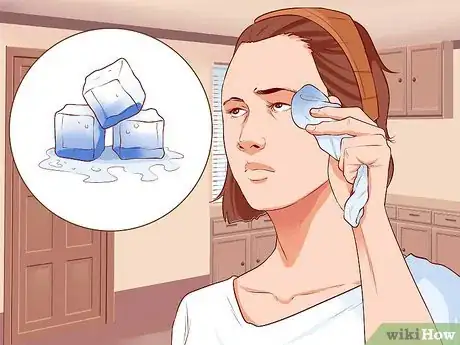
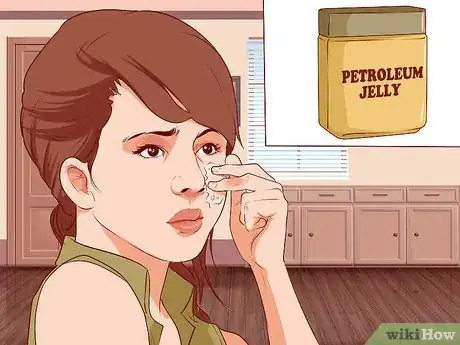

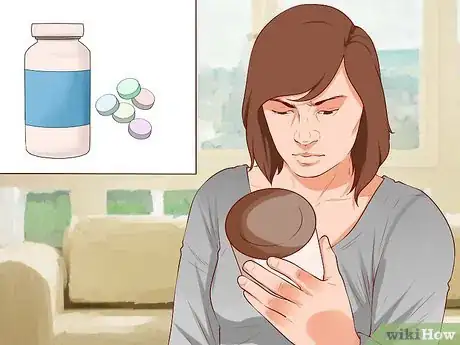
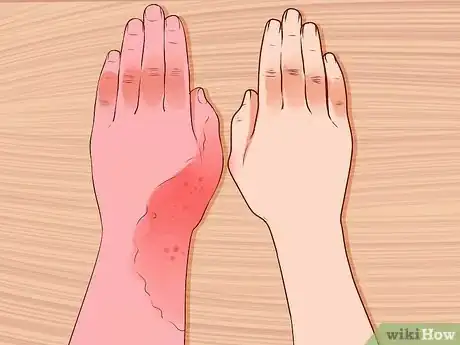
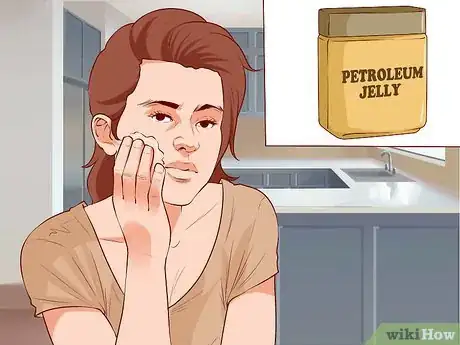

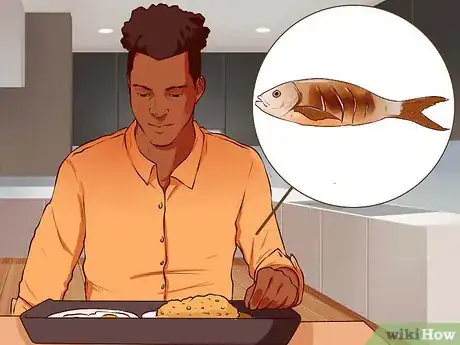
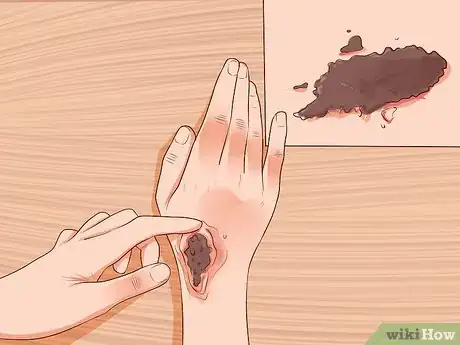
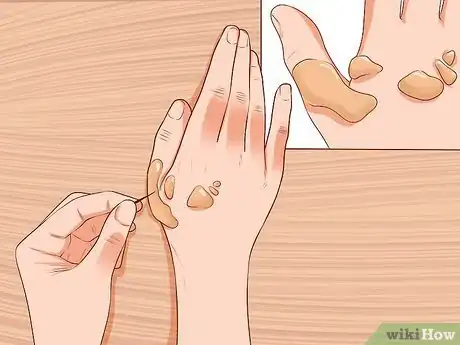



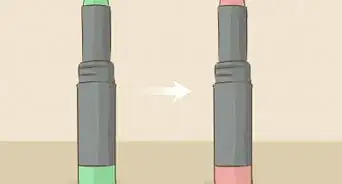
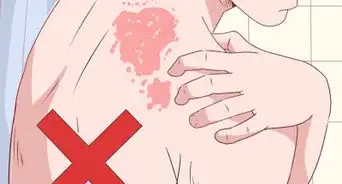





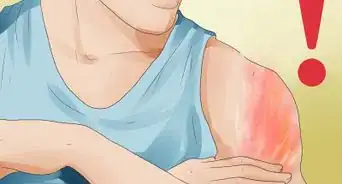

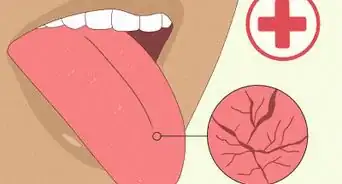

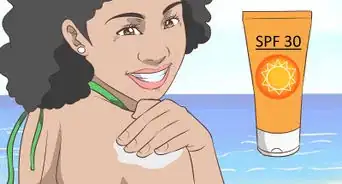








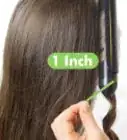


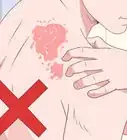



































Medical Disclaimer
The content of this article is not intended to be a substitute for professional medical advice, examination, diagnosis, or treatment. You should always contact your doctor or other qualified healthcare professional before starting, changing, or stopping any kind of health treatment.
Read More...